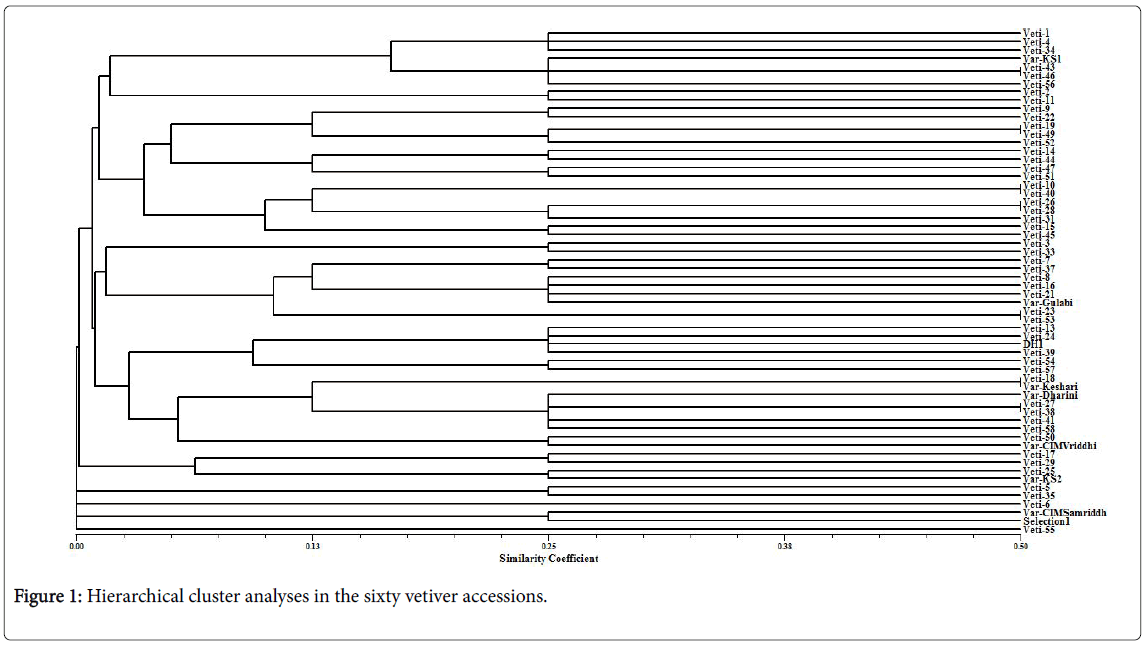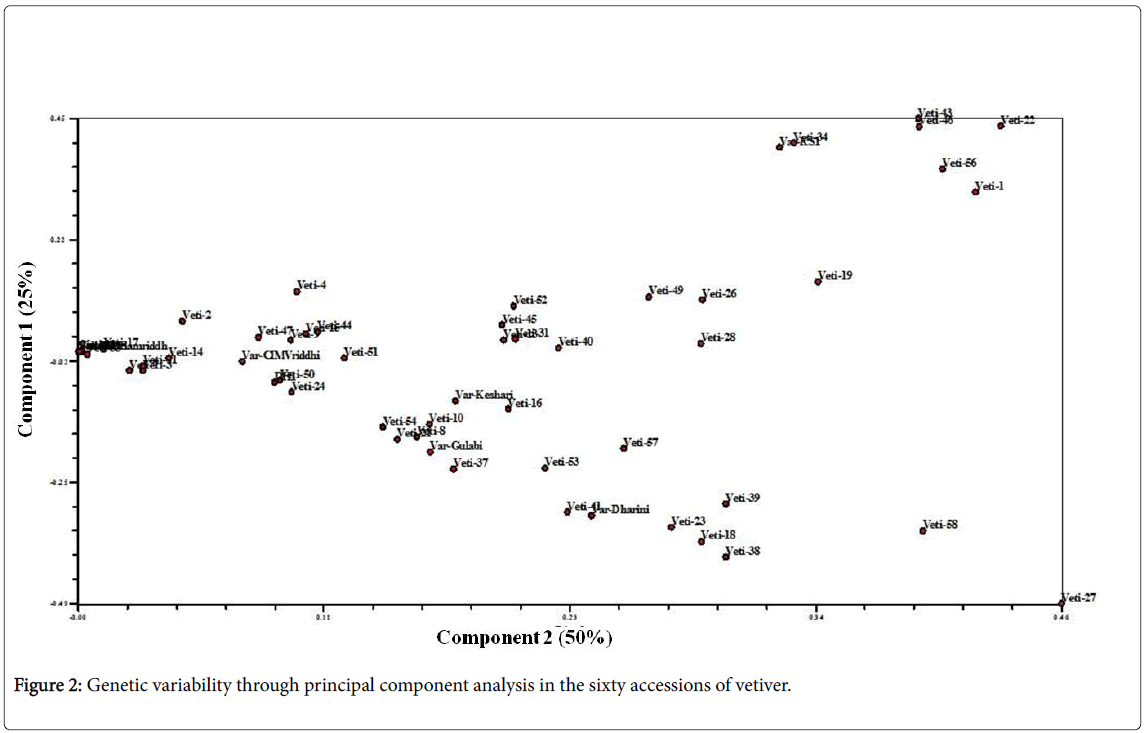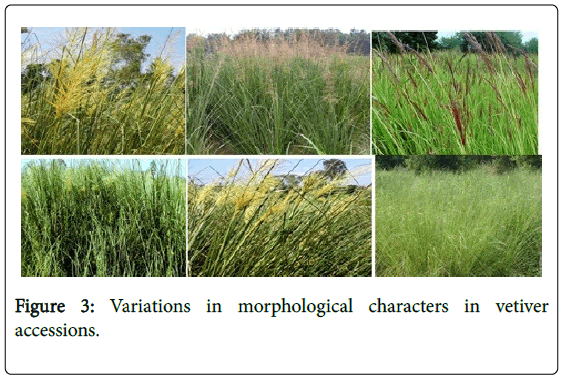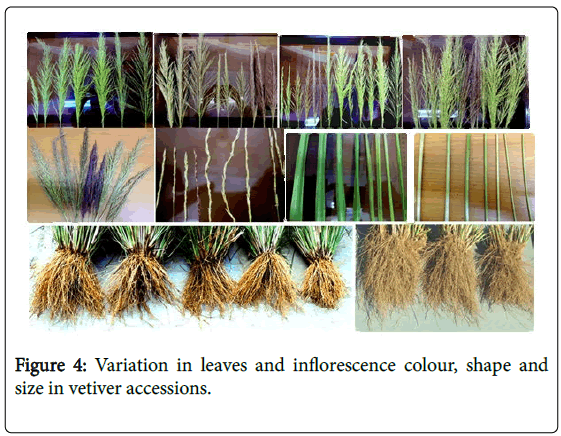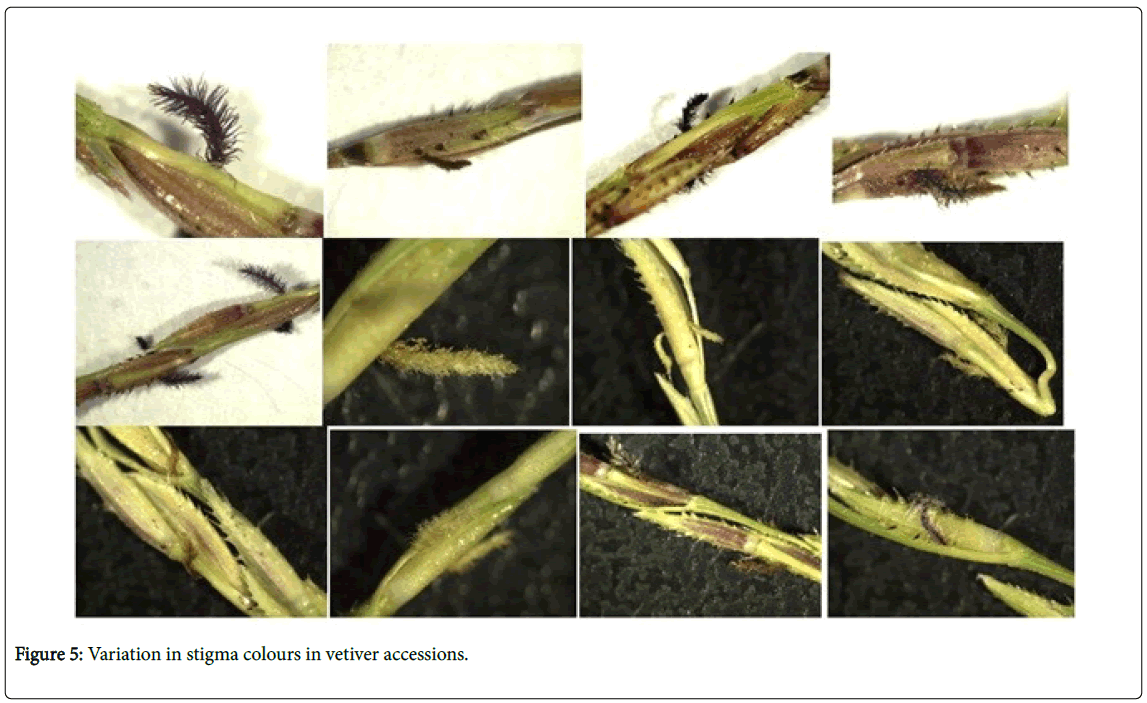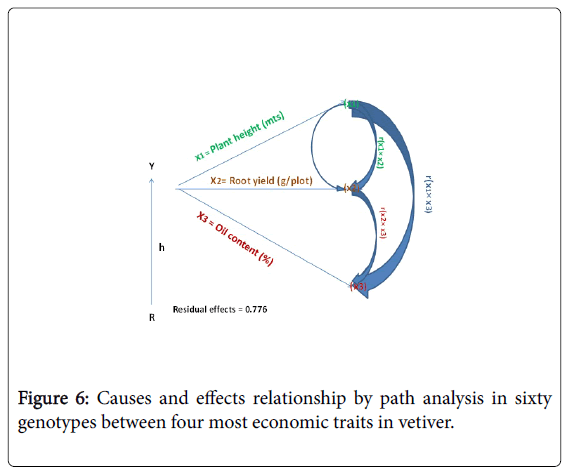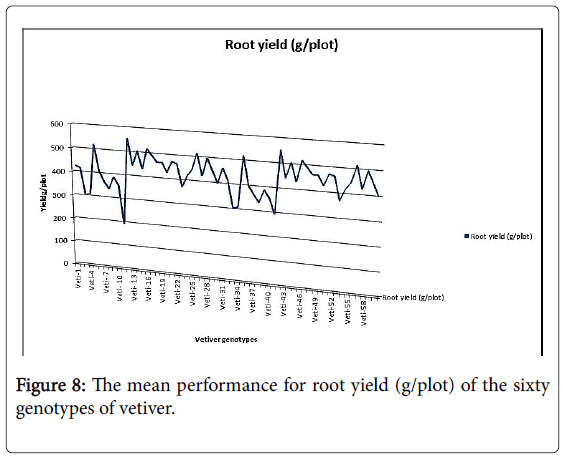Phylogenetic Relationships, Path and Principal Component Analysis for Genetic Variability and High Oil Yielding Clone Selection in Vetiver (Vetiveria zizanioides L.) Nash
Received: 27-Mar-2018 / Accepted Date: 14-May-2018 / Published Date: 16-May-2018
Abstract
Phylogenetic relationships, principal component and path analysis for genetic variability, heritability and genetic advance were studied in order to understand yield genetic parameters in sixty vetiver accessions. The coefficient of variation was low to high for nearly all traits. The ^h2 (BS) was low to medium (46.54 to 67.28%) for all the characters except high for oil yirld (88.97%). The oil yield was positive and significantly correlated with root yield (0.326**, 0.269**); essential oil content (0.549**, 0.512**) and plant height (0.409**, 0.210*). The root yield was also positively and significantly associated with essential oil content (0.368**, 0.226*). The further estimation of genetic variability through phylogenetic relationships dendrogram and principal component analysis (PCA) on vetiver genotypes shows that Veti-12, Veti-42, Veti -5 and Veti-35 were found closely related to each other than other accessions. Principal coordinate components accounted for 25% and 50% of the genetic similarity variance in the vetiver accessions. The path coefficient analysis revealed that the highest direct contribution to oil yield was made by oil content (0.475), plant height (0.299) and root yield (0.041). The indirect contribution was invariably large via plant height and essential oil content. The high essential oil yielding vetiver genotypes, namely Veti-12, Veti-42, Veti-5 and Veti-35 were found suitable for cultivation on the commercial scale.
Keywords: Associations; Heritability; Path analysis; Phylogenetic relationships; Principal component analysis
Introduction
Vetiveria zizanioides (L.) Nash ex Small syn. Chrysopogon zizanioides Roberty) is a perennial aromatic grass belonging to the poaceae family. This aromatic grass is popularly known as Khas Khas, Khas or Khus grass in India. It is a densely tufted grass, found throughout the plains and lower hills of India, particularly on the riverbanks and rich marshy soil. Vetiver has been known to India since ancient times. It has been considered as a high class perfume and copper plate inscriptions list the perfume as one of the articles used by royalty. Two species of Vetiveria are found in India, of which V. zizanioides is the common source of the well-known oil of Vetiver, which is used in medicine and in perfumery. Khus grass grows wild in many states, namely Haryana, Uttar Pradesh, Rajasthan, Gujarat, Bihar, Orissa, Madhya Pradesh and throughout South India. It is systematically cultivated in the North Indian states of Rajasthan, Uttar Pradesh, Bihar, Chhattisgarh, Madhya Pradesh, Maharashtra, Odisha, Punjab and in the South Indian states of Kerala, Tamil Nadu, Karnataka and Andhra Pradesh. The yield from the cultivated crops, however, meets only a very small percentage of the requirements of the country. The bulks of the roots used for cooling purposes and for the extraction of the oil are obtained from the wild [1].
The North and South Indian peninsula is considered as vetiver primary centre of origin from where it is said to have spread over the world of its value in the production of aromatic oil [2-6]. Vetiver (Vetiveria zizanioides ) is a C4 plant with a deep root system, high biomass production, high efficiency of photosynthesis, and can be multiplied by tillering. Vetiver can grow both in wetland and upland area [4-8]. Heat and water are more important than soil texture to vetiver. Vetiver grows fast in regions with high temperature and high rainfall. The growth of root system of vetiver is affected by temperature, rainfall intensity and soil. Appropriate harvest time promotes the growth of root and tiller. Normally the crop of vetiver is uprooted for their roots after 15 and 18 months, but now 12 months and also six months uprooting varieties are also available in India for commercial cultivation developed and released by CSIR-Central Institute of Medicinal and Aromatic Plants, P.O. CIMAP, Lucknow, U.P. PIN 226 015 (India) of planting when the oil content in the roots is the highest. Thus a crop planted in July is ready for harvest in September- October next year. The essential oil of vetiver is one of the most important raw materials in perfumery both as a fixative and as a fragrance ingredient. It has extensive applications in toiletries and cosmetic industries and vetiver root is also important in traditional medicine as a carminative, stimulant and diaphoretic. Vetiver oil possesses sedative property and has been traditionally used in aromatherapy for relieving stress, anxiety, nervous tension and insomnia for a long time. However, there is a lack of scientific experiment to prove these effects by way of inhalation.
In India to make its cultivation cost-effective requires genetic study for genetic variability amongst available genotypes of vetiver, as varietal development depends upon the nature and amount of existing genetic variability. The present study was conducted to estimate the nature and amount of genetic variation in the four most economic traits in the sixty genotypes/accessions of vetiver in order to understand the associations and character contribution towards essential oil for further vetiver crop improvement.
Materials and Methods
Sixty genotypes of vetiver (Vetiveria zizanioides (L.) Nash ex Small syn. Chrysopogon zizanioides Roberty), assembled from indigenous and exotic origin were used as the materials for this study.
The Accessions namely, Veti-10, Veti-11, Veti-27, Veti-31, Veti-49, Veti-53, Veti-54, Veti-56 were the Lucknow local collections accessions maintained CSIR – CIMAP, Lucknow in the department of Genetics and Plant breeding (Table 1). .The vetiver accessions Veti -7, 8 and 24 are in CSIR-CIMAP gene bank collections from the year 1981. They were evaluated at the CSIR-Central Institute of Medicinal and Aromatic Plants, P.O. CIMAP, Lucknow, U.P. 226 015 (India). Research Farm in the two continuous years: 2014-2015 and 2015-2016 in a randomized complete block design replicated thrice. The slips were planted in 60 × 60 cm rows to row/plant to plant. The crops received normal intercultural operations, irrigation, and fertilizer applications (100:80:40 kg N, P2 O5, and K2O per hectare). Plants were harvested by uprooting twelve months after planting. Essential oil was extracted in the roots by hydro-distillation using Clevenger type apparatus [9].
| S.no | Accession’s code | Origin | S.no. | Accession’s code | Origin |
|---|---|---|---|---|---|
| 1. | Veti-1 | Muzafferpur (Bihar) (India) | 31. | Veti-31 | CIMAP, Lucknow, (India) |
| 2. | Veti-2 | Ghana Sanctuary, Bharat Pur, Rajasthan (India) | 32. | Veti-32 (KS-1) | CIMAP, Lucknow, (India) |
| 3. | Veti-3 | Jannu Tawi, Jammu and Kashmir | 33. | Veti-33 | Jhansi, U.P. (India) |
| 4. | Veti-4 | Phagwara, Punjab (India) | 34. | Veti-34 | Moradabad, U.P. (India) |
| 5. | Veti- 5 | Cuttak, Orissa (India) | 35. | Veti-35 | Kukra, Lakhimpur (Kheri) U.P. (India) |
| 6. | Veti- 6 | Bhubeneswer, Orissa (India) | 36. | Veti-36 (Gulabi) | CIMAP, Lucknow, (India) |
| 7. | Veti- 7 | Thailand | 37. | Veti-37 | Nimach, M.P. (India) |
| 8. | Veti- 8 | Haiti | 38. | Veti-38 | Trissur (Kerala) (India) |
| 9. | Veti- 9 | Nimach, M.P. (India) | 39. | Veti-39 | Gandhi Nagar, Gujarat (India) |
| 10. | Veti- 10 | CIMAP, Lucknow, (India) | 40. | Veti-40 | Basari Ghat U.P. (India) |
| 11. | Veti- 11 | CIMAP, Lucknow, (India) | 41. | Veti-41 | Musanagar, U.P. (India) |
| 12. | Veti -12 (Samriddhi) | CIMAP, Lucknow, (India) | 42. | Veti-42 (Selection-1) | CIMAP, Lucknow, (India) |
| 13. | Veti- 13 | Baba Ganj, U.P. (India) | 43. | Veti-43 | Musanagar, U.P. (India) |
| 14. | Veti- 14 | Mathura, U.P. (India) | 44. | Veti-44 | Nimach, M.P. (India) |
| 15. | Veti- 15 | Pantnagar, Uttrakhand (India) | 45. | Veti-45 | Thrissur, Kerala (India) |
| 16. | Veti-16 | Muzafferpur (Bihar) (India) | 46. | Veti-46 | Razaganj, Lakhimpur (Kheri), U.P. (India) |
| 17. | Veti-17 | Ghana Sanctuary, Bharat Pur, Rajasthan (India) | 47. | Veti-47 | Travancore, Kerala, (India) |
| 18. | Veti-18 | Jannu Tawi, Jammu and Kashmir | 48. | Veti-48 (Kesri) | CIMAP, Lucknow, (India) |
| 19. | Veti-19 | Phagwara, Punjab (India) | 49. | Veti-49 | CIMAP, Lucknow, (India) |
| 20. | Veti-20 (Dharini) | CIMAP, Lucknow, (India) | 50. | Veti-50 | Ghaghraghat, U.P. (India) |
| 21. | Veti- 21 | Bhubeneswer, Orissa (India) | 51. | Veti-51 | Reunion, Island |
| 22. | Veti-22 | Agra, U.P., (North India) | 52. | Veti-52 | Chennai, Andhra Pradesh (India) |
| 23. | Veti-23 | Musanagar, U.P. (India) | 53. | Veti-53 | CIMAP, Lucknow, (India) |
| 24. | Veti-24 | Haiti | 54. | Veti-54 | CIMAP, Lucknow, (India) |
| 25. | Veti-25 | Pune, Maharastra (India) | 55. | Veti-55 | Indonesia |
| 26. | Veti-26 | Kanpur, U.P. (India) | 56. | Veti-56 | CIMAP, Lucknow, (India) |
| 27. | Veti-27 | CIMAP, Lucknow, (India) | 57. | Veti-57 | Bharat Pur, Rajasthan, (India) |
| 28. | Veti-28 | New Delhi, (India) | 58. | Veti-58 | Thrissur, Kerala (India) |
| 29. | Veti-29 | Barabanki, U.P. (India) | 59. | Veti-59 (KS-2) | CIMAP, Lucknow, (India) |
| 30. | Veti-30 (DH-1) | CIMAP, Lucknow, (India) | 60. | Veti-60 (Vriddhi) | CIMAP, Lucknow, (India) |
Table 1: Origin of sixty genotypes of vetiver maintained at CSIR-CIMAP, Lucknow.
The morphometric observations were recorded for four most economic traits, namely plant height (cm), root yield (g/plot), oil content (%) and oil yield (g/plot) for statistical analysis.
Statistical analysis
The pooled mean values of two years for the all the four most economic characters were subjected to statistical analyses was done using the statistical software 0.3 version and Sigma plot 13.0 version, available in the Department of Genetics and Plant Breeding of the CSIR-Central Institute of Medicinal and Aromatic Plants, Lucknow, U.P. (India) for correlation and path coefficient analyses based on the standard methods as described by Dewey and Lu [10-12].
A dendrogram was also generated by euclidian distance similarity matrix to show the different accession relationships using the unweighted pair group method with arithmetic mean (UPGMA) by NTSYS-pc 2.02. The average similarity matrix was used to generate a tree for cluster analysis with UPGMA. Hierarchical cluster analysis was carried out based on essential oil components present in different taxa. The matrix obtained was used to construct phylogenetic tree based on UPGMA method. Further, Principal Coordinate Analysis (PCA) was performed based on the matrix calculated from the marker data with the software package NTSYS-pc 2.02.
Results and Discussion
The analysis of variance showed highly significant (p<0.01) differences among the pooled mean of the two years of the sixty accessions for all the traits indicating high variations among the vetiver accessions. This was also well reflected by the values of means, range and C.D. (Table 2). The coefficient of variation give an idea of relative variability present in the accessions (genotypic CVg: 7.16 to 47.93 and (phenotypic CVp: 10.25 to 50.81)%. The phenotypic variance (σ2p) was>σ2g (variance due to genotype) and variance due to genotype (σ2g) was>σ2e (variance due to environment) for all the four traits. The heritable portion of phenotypic variance reflected by the size of σ2g relative to σ2p expressed as ^h2 (BS) was low to medium (46.54 to 67.28%) for all the traits except high for essential oil yield (88.97%). Therefore, it is depicted from results that the oil yield was highly influenced by environment factors than other three characters (Table 2). According to all the four characters studied within and between the genotypes expressed high genetic variability.
| S. No. | Characters | Genetic parameters | |||||||||||
|---|---|---|---|---|---|---|---|---|---|---|---|---|---|
| 2g | 2p | 2e | GCV | PCV | ˆh2BS% | GA | CV(%) | SED | CD (5%) | CD (1%) | Range of mean |
||
| 1. | Plant height | 0.012 | 0.025 | 0.013 | 7.16 | 10.25 | 48.86 | 0.11 | 7.33 | 0.092 | 0.18 | 0.23 | 1.35-1.80 |
| 2. | Root yield (g/plot) | 8138.06 | 12096.36 | 3958.32 | 20.95 | 25.55 | 67.28 | 125.02 | 14.61 | 51.37 | 71.56 | 94.44 | 194.17-555.00 |
| 3. | Essential oil content | 0.081 | 0.175 | 0.011 | 31.56 | 46.27 | 46.54 | 0.27 | 11.46 | 0.087 | 0.17 | 0.22 | 0.54-1.99 |
| 4. | Oil yield | 3.06 | 3.44 | 0.379 | 47.93 | 50.81 | 88.97 | 3.20 | 16.88 | 0.503 | 0.99 | 1.31 | 0.65-7.17 |
Table 2: Estimates of variance components and other allied genetic parameters the four traits of sixty accessions of vetiver.
The further estimation of genetic variability through phylogenetic relationships and principal component analysis (PCA), dendrogram of vetiver genotypes shows that Veti-12 followed by Veti-42, Veti -5 and Veti-35 were found closely related to each other than other accessions (Figure 1). Further, Principal Coordinate Analysis (PCA) was also performed based on the matrix calculated from the marker data the two - dimensional PCA and dendogram derived on the basis of four character of sixty vetiver genotypes illustrated that the first two principal coordinate components accounted for 25% and 50% of the genetic similarity variance in Figures 2-5.
Heritability in broad sense (^h2 BS) and genetic advance (GA) is more reliable for selection than that with low genetic advance (GA). The estimate of heritability broad sense in percent (^h2 BS%) and corresponding genetic advance (GA) were low for the two - plant height (48.86; 0.11) and essential oil content (46.54; 0.27); medium to high for root yield (67.28; 125.02) and high and low for the oil yield (88.97 and 3.20) with C.V.% ranged 7.33 to 16.88% ; SED 0.087 to 51.37, respectively. Hence, the plant height and essential oil content are not easy for genetic improvement/selection. On the other hand essential oil and root yield traits were most favourable to direct selection for high essential oil yielding accessions of vetiver.
Nevertheless, including genetic advance and heritability, the attachments between each other in different traits also play an important role for success of genetic improvement or selection in any crops including vetiver. The genotypic associations were greater than phenotypic associations for all the four traits (Table 3). The oil yield had positive and significant correlation with root yield (0.326**, 0.269**); essential oil content (0.549**, 0.512**) and plant height (0.409**, 0.210*) at both genotypic and phenotypic level. The root yield had significantly positive correlations with essential oil content (0.368**, 0.226*). The plant height was positively and highly significantly associated with root yield (0.368**) and significant with essential oil content (0.199*) at genotypic level only. Therefore, these traits were found suitable for selection. These traits were also reinforced by high values of co-heritability. These results are in accordance with other reports in vetiver crops [13-18]. The environmental correlations were found weak associations in positive or in negative directions among characters (Tables 2 and 3).
| Correlations | Plant height (mts) | Root yield (g/plot) | Essential oil content (%) | Oil yield (g/plot) |
|---|---|---|---|---|
| Plant height (mts) | - | 0.368** 0.173 |
0.199* 0.099 |
0.409** 0.210* |
| Root yield (g/plant) | -0.094 1.222 |
- | 0.368** 0.226* |
0.326** 0.269** |
| Essential oil content (%) | 0.008 0.956 |
0.048 0.912 |
- | 0.549** 0.512** |
| Oil yield (g/plot) | -0.250 1.282 |
0.085 0.940 |
-0.171 1.133 |
- |
*-p<0.05; **-p<0.01, respectively (compared with standard ‘r’ table values at n-2 error degree of freedom with two variables); Genetic (rg), phenotypic (rp) correlations are in upper diagonal and environmental correlations and co-heritability in broad sense (COH(bs)) are in bellow diagonal.
Table 3: Genetic (rg), phenotypic (rp) and environmental correlations (re) for the four economic characters in vetiver
The correlations were further portioned in to direct and indirect effects to establish the causes and effects relationship among the essential oil yield and its components characters. The direct effects of oil content (0.475) and plant height (0.299) followed by root yield (0.041) towards the essential oil yields were high. However, a very strong direct positive association of essential oil yield and root yield along with essential oil yield were recorded in the study suggesting their consistency of good selection criterion for these traits.
The indirect contribution towards essential oil had large via plant height and essential oil content with residual effect (R=0.776) was little high (Table 4, Figures 6-8).
| S.No. | Path ways of associations | Direct effects (P) | Indirect effects (P × r) | Correlations (r) dry root yield |
|---|---|---|---|---|
| 1. | Plant height (mts) | |||
| (a) | Direct effect | 0.299 | ||
| (b) | Indirect effect via Root yield (g/plant) |
0.015 | ||
| Essential oil content (%) | 0.090 | |||
| Total effect | 0.409 | |||
| 2. | Root yield (g/plot) | |||
| (a) | Direct effect | 0.041 | ||
| (b) | Indirect effect via Plant height (mts) |
0.110 | ||
| Essential oil content (%) | 0.175 | |||
| Total effect | 0.326 | |||
| 3. | Essential oil content (%) | |||
| (a) | Direct effect | 0.475 | ||
| (b) | Indirect effect via Plant height (mts) |
0.528 | ||
| Root yield (g/plot) | -0.270 | |||
| Total effect | 0.549 |
Residual effects = 0.7768
Table 4: Direct (bold) and indirect effects on four traits related to path analysis in vetiver.
The rest of direct and indirect effects and correlations were very meagre. Therefore, it revealed from the study that root yield and essential oil content are the most important component traits to improve essential oil yield in vetiver crop. In nut shell, we obtained an estimate of intra- and intergroup diversity, association’s, characters contributions with different morphological plants differences including roots, inflorescence, anthers and stigma length size and colour (Figures 3-5) between vetiver accessions and traits. Finally, on the basis of above findings the accessions Veti-12 followed by Veti-42, Veti -5 and Veti-35 were found suitable for cultivation on the commercial scale.
Conclusion
Genetic improvement of vetiver is depending upon genetic variability, associations and direct/indirect contribution of the traits in the accessions. The coefficient of variation was low to high for nearly all the traits CVg=7.16 - 47.93 and CVp=10.25 - 50.81%. The ^h2 (BS) was low to medium (46.54 to 67.28%) for all the characters except high for oil yield (88.97%). The correlation coefficients among traits revealed that the oil yield correlated with root yield (0.326**, 0.269**); essential oil content (0.549**, 0.512**) and plant height (0.409**, 0.210*). The root yield also had positive and significant association with essential oil content (0.368**, 0.226*) at both genetic and phenotypic levels. The path coefficient expressed that the highest direct contribution to oil yield was denoted by oil content (0.475); plant height (0.299) and root yield (0.041). The indirect effects were high via plant height and essential oil content. Finally, the accessions Veti-12 followed by Veti-42, Veti -5 and Veti-35 were found suitable for high essential oil yield and cultivation.
Acknowledgement
Author is highly thankful to CSIR for funding via Sanction No. 21 (1020)/16/EMR-II dated 18-11-2016 and The Director CSIR-CIMAP for providing required facilities for experiments.
References
- Lal RK (2012) on genetic diversity in germplasm of vetiver (Vetiveria zizanioides L. Nash). Industrial Crop and Products 43: 93-98.
- Virmani OP, Datta SC, (1975) Vetiveria zizanioides (L.) Nash. Indian Perfumer 19: 95-73.
- Lavania UC (2000) Primary and secondary centres of origin of vetiver and its dispersion. In: Second International Proceedings on Vetiver and the Environment Conference, Vetiver, Phetchaburi Province Thailand, 18-22 January, pp: 432-434.
- Lal Raj Kishori, Sarkar Sougata, Zaim Mohammad (2017a) Genotype × environment interaction, rhizome yield stability and selection for region specific stable genotypes in turmeric (Curcuma longa L.). Trends Phytochem. Res. 1: 93-102
- Lal Raj Kishori, Singh smita, Gupta Pankhuri, Dhawan Sunita, Singh Sarkar, et al. (2017b) Quantification of ursolic acid, correlations and contribution by other traits towards accumulation of ursolic acid in six Ocimum species. Trends Phytochem. Res. 1: 39-46
- Lal Raj Kishori, Chanotiya CS, Gupta Pankhuri, Sarkar Sougata, Singh Smita, et al. (2018) Phenotypic stability, genotype ×environmental interactions, and cultivar recommendations for essential oil yield in khus aromatic grass (Chrysopogon zizanioides (L.) Roberty). Industrial Crops & Products 111: 871-877.
- Hussain A, Sharma JR, Puri HS, Tayagi BR (1984) Vetiveria zizanioides (L.) Nash Vetiver or Khus. Status Report on Genetic Resources on Important Medicinal and Aromatic Plants in South Asia. CIMAP, Lucknow, India, (behalf of International Board of Plant Genetic Resources Rome). pp. 273-304.
- Pareek SK (1994) Germplasm collection and evaluation of vetiver. In: Rana RS, Singh B, Kopar MN, Mathur R, Kochar S, Dahoon SS (Editorials), Plant Genetic Resources Exploration, Evaluation and Maintenance. NBPGR, New Delhi, pp. 275-281.
- Clevenger JF (1928) Apparatus for the determinations of volatile oils. J Am Pharm Assoc. 17-345.
- Dewey DR, Lu KH (1959) A correlation and path coefficient analysis components of crested wheat grass seed production. Agron J. 51: 515-518.
- Panse VG, Sukhatme PV (1967) Statistical Methods for Agricultural Workers, 2nd ed. Indian Council of Agricultural Research, New Delhi.
- Singh RK, Chaudhary BD (2014) Variance and covariance, path analysis. Biometrical Methods in Quantitative Genetic. Kalyani Publisher, New Delhi (Reprint). pp: 39-78.
- Singh SP (1988) Genetic divergence over environments in pearl millet (Pennisetum typhoides). Genet. Agr. 42: 35-41.
- Lal RK, Sharma JR, Naqvi AA (1999) Genetic variability and exploitation in vetiver grass, Vetiveria zizanioides (L.) Nash. J Med. Aromat Plant Sci. 21: 963-968.
- Lal RK, Sharma JR, Misra HO (1997a) Genetic diversity in germplasm of vetiver grass, Vetiveria zizanioides (L.) Nash. J Herbs Spices Med. Plant. 5: 1-12.
- Lal RK, Sharma JR, Misra HO (1997b) Varietal selection for high root and oil analysis in vetiver Vetiveria zizanioides (L.) Nash. J Med. Aromat Plant Sci. 19: 1-4.
- Lal RK, Gupta P, Gupta V, Sarkar S, Singh S (2013) Genetic variability and character associations in vetiver (Vetiveria zizanioides L. Nash). Industrial Crop and Products. 49: 273-277.
- Lal RK (2015) Quantification of adaptability and stability among genotypes/cultivars for root yield in Ashwagandha (Withania somnifera L.). Industrial Crops and Products. 77: 648-657.
Citation: Lal RK, Gupta P, Sarkar S (2018) Phylogenetic Relationships, Path and Principal Component Analysis for Genetic Variability and High Oil Yielding Clone Selection in Vetiver (Vetiveria zizanioides L.) Nash. J Plant Genet Breed 2: 105.
Copyright: © 2018 Lal RK, et al. This is an open-access article distributed under the terms of the Creative Commons Attribution License, which permits unrestricted use, distribution, and reproduction in any medium, provided the original author and source are credited.
Share This Article
Open Access Journals
Article Usage
- Total views: 4759
- [From(publication date): 0-2018 - Apr 06, 2025]
- Breakdown by view type
- HTML page views: 3884
- PDF downloads: 875

